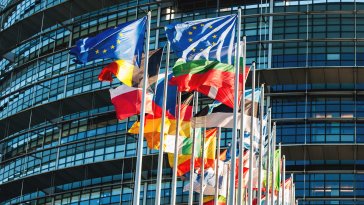Investment
Institute
Market Views

Remember “Trumpnomics”?
- 11 March 2024 (10 min read)
KEY POINTS
Consumer confidence is surprisingly low in the US. This does not bode well for Biden’s re-election bid. We look into what could be the trade policy of another Trump presidency.
Christine Lagarde was quite straightforward about anchoring June as the likeliest start for the rate cuts.
Donald Trump’s victorious Super Tuesday, combined with so far favourable decisions by the Supreme Court, make it now highly likely that the November duel will be a re-run of 2020 at a time when, in the general polls, Joe Biden is slightly trailing his Republican opponent. The current President used his State of the Union speech to highlight the country’s strong economic performance. What is however striking is that consumer confidence is now significantly lower than what a so far successful model combining the unemployment rate, inflation and equity prices suggests. It seems the US extreme political polarization is colouring citizens’ assessment of the state of the economy, but Biden cannot count of Democrats’ enthusiasm about their economic conditions. Indeed, even they assess them as slightly below their long-term average. Looking back at all incumbent’s re-election bids since 1972, the level of consumer confidence at this stage of the campaign is lower than those seen in successful bids. Now, elections are not necessarily won on the economy. Donald Trump’s lost his own re-election bid in 2020 despite a high level of consumer confidence. We think it is however time to start looking hard at what a possible second Trump mandate could mean. We focus on a recent contribution of Peter Navarro, Donald Trump’s former international trade envoy. He unveiled in detail his plan for the US to threaten – and potentially ultimately enforce – additional custom levies to systematically bring the US tariffs on par with the tariffs imposed by the US clients. Some of these elements have already found their way into Donald Trump’s campaign. This would hurt geopolitical allies of the US such as the EU, as well as an emerging power such as India, on top of China, the explicit key target there. Separately, we think Christine Lagarde hinted quite clearly as June as the likeliest moment for the first rate cut. The ECB still needs more clarity on wage growth in particular, but the more dovish than expected new batch of forecasts signals a clear readiness not to waste too much time before starting to remove some of the current policy restriction.
Download the full article
Download report (458.59 KB)
Disclaimer
This document is for informational purposes only and does not constitute investment research or financial analysis relating to transactions in financial instruments as per MIF Directive (2014/65/EU), nor does it constitute on the part of AXA Investment Managers or its affiliated companies an offer to buy or sell any investments, products or services, and should not be considered as solicitation or investment, legal or tax advice, a recommendation for an investment strategy or a personalized recommendation to buy or sell securities. Due to its simplification, this document is partial and opinions, estimates and forecasts herein are subjective and subject to change without notice. There is no guarantee forecasts made will come to pass. Data, figures, declarations, analysis, predictions and other information in this document is provided based on our state of knowledge at the time of creation of this document. Whilst every care is taken, no representation or warranty (including liability towards third parties), express or implied, is made as to the accuracy, reliability or completeness of the information contained herein. Reliance upon information in this material is at the sole discretion of the recipient. This material does not contain sufficient information to support an investment decision. Neither MSCI nor any other party involved in or related to compiling, computing or creating the MSCI data makes any express or implied warranties or representations with respect to such data (or the results to be obtained by the use thereof), and all such parties hereby expressly disclaim all warranties of originality, accuracy, completeness, merchantability or fitness for a particular purpose with respect to any of such data. Without limiting any of the foregoing, in no event shall MSCI, any of its affiliates or any third party involved in or related to compiling, computing or creating the data have any liability for any direct, indirect, special, punitive, consequential or any other damages (including lost profits) even if notified of the possibility of such damages. No further distribution or dissemination of the MSCI data is permitted without MSCI’s express written consent. Issued in the UK by AXA Investment Managers UK Limited, which is authorised and regulated by the Financial Conduct Authority in the UK. Registered in England and Wales No: 01431068. Registered Office: 22 Bishopsgate London EC2N 4BQ In other jurisdictions, this document is issued by AXA Investment Managers SA’s affiliates in those countries.





